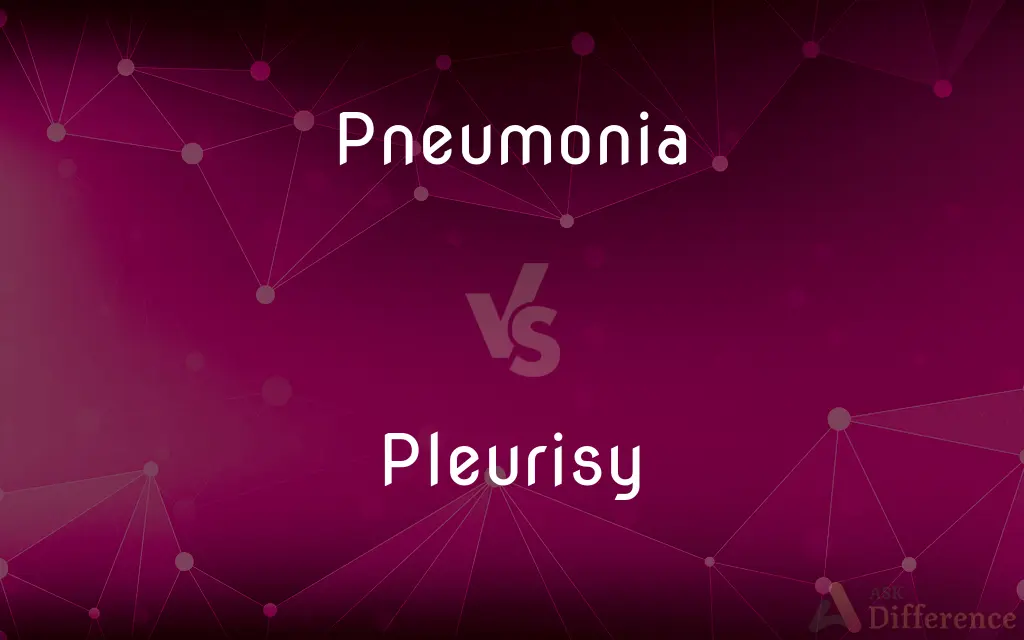Pneumonia vs. Pleurisy — What's the Difference?
Edited by Tayyaba Rehman — By Fiza Rafique — Updated on September 26, 2023
Pneumonia an inflammatory lung condition caused by infection, resulting in lung tissue inflammation and fluid accumulation. Pleurisy an inflammation of the pleura (lining of the lungs and chest cavity), causing sharp chest pain, especially during breath.

Difference Between Pneumonia and Pleurisy
Table of Contents
ADVERTISEMENT
Key Differences
Pneumonia: Primarily affects the lung tissue, leading to infection-related symptoms such as fever and cough. Pleurisy: Involves inflammation of the pleura, resulting in chest pain, especially with breathing.
Pneumonia: Common symptoms include high fever, cough with phlegm, and difficulty breathing. Pleurisy: Characterized by sharp, stabbing chest pain, particularly when inhaling deeply.
Pneumonia: Diagnosed through physical exams, chest X-rays, and lab tests to identify the responsible pathogen. Pleurisy: Diagnosed based on a patient's medical history, physical examination, and imaging tests to assess pleural inflammation.
Compare with Definitions
Pneumonia
Inflammation of lung tissue typically due to infection.
His pneumonia improved with antibiotics and rest.
Pleurisy
Inflammation of the pleural membranes surrounding the lungs.
Pleurisy can make it painful to take deep breaths.
ADVERTISEMENT
Pneumonia
A respiratory condition marked by lung inflammation.
Pneumonia can be severe, especially in older adults.
Pleurisy
Inflammation of the pleura causing sharp chest pain.
She experienced pleurisy pain with each breath.
Pneumonia
Infection in the air sacs of the lungs causing pneumonia.
The doctor prescribed antibiotics to treat bacterial pneumonia.
Pleurisy
Chest condition marked by pleural lining inflammation.
Pleurisy can be a symptom of an underlying lung issue.
Pneumonia
Lung disease characterized by inflammation and fluid buildup.
Pneumonia can lead to severe chest congestion.
Pleurisy
Chest discomfort worsened by breathing and coughing.
The doctor prescribed pain relievers for her pleurisy.
Pneumonia
Lung infection causing fever, cough, and breathing difficulty.
After contracting pneumonia, she was hospitalized for treatment.
Pleurisy
Condition characterized by pleural lining irritation.
Pleurisy often occurs alongside respiratory infections.
Pneumonia
Pneumonia is an inflammatory condition of the lung primarily affecting the small air sacs known as alveoli. Symptoms typically include some combination of productive or dry cough, chest pain, fever and difficulty breathing.
Pleurisy
Pleurisy, also known as pleuritis, is inflammation of the membranes that surround the lungs and line the chest cavity (pleurae). This can result in a sharp chest pain while breathing.
Pneumonia
Lung inflammation caused by bacterial or viral infection, in which the air sacs fill with pus and may become solid. Inflammation may affect both lungs (double pneumonia) or only one (single pneumonia).
Pleurisy
Inflammation of the pleura, usually occurring as a complication of a disease such as pneumonia, accompanied by accumulation of fluid in the pleural cavity, chills, fever, and painful breathing and coughing.
Pneumonia
An acute or chronic disease marked by inflammation of the lungs, usually caused by a bacterium, virus, or other infectious agent.
Pleurisy
(pathology) Inflammation of lung pleura.
Pneumonia
An acute or chronic inflammation of the lungs caused by viruses, bacteria or other microorganisms, or sometimes by physical or chemical irritants.
Pleurisy
An inflammation of the pleura, usually accompanied with fever, pain, difficult respiration, and cough, and with exudation into the pleural cavity.
Pneumonia
Inflammation of the lungs.
Pleurisy
Inflammation of the pleura of the lungs (especially the parietal layer)
Pneumonia
Respiratory disease characterized by inflammation of the lung parenchyma (excluding the bronchi) with congestion caused by viruses or bacteria or irritants
Common Curiosities
Is pneumonia contagious?
Pneumonia can be caused by contagious pathogens such as bacteria or viruses, making some types of pneumonia contagious.
Who is at higher risk of developing severe pneumonia?
Older adults, young children, individuals with weakened immune systems, and those with underlying health conditions are at higher risk.
What are common symptoms of pneumonia?
Common symptoms include fever, cough with phlegm, difficulty breathing, and chest pain.
How is pleurisy diagnosed?
Diagnosis is typically based on a patient's medical history, physical examination, and imaging tests such as chest X-rays or CT scans.
What is pneumonia?
Pneumonia is an inflammatory lung condition typically caused by infection, resulting in lung tissue inflammation and fluid accumulation.
How is pneumonia treated?
Treatment involves antibiotics, antivirals, or antifungal medications, depending on the cause, along with supportive care.
What causes pleurisy?
Pleurisy can be caused by viral infections, lung conditions, or autoimmune diseases that lead to inflammation of the pleural lining.
What is pleurisy?
Pleurisy is an inflammation of the pleura, the lining of the lungs and chest cavity, causing sharp chest pain, especially during breathing.
What are the main symptoms of pleurisy?
The primary symptom of pleurisy is sharp, stabbing chest pain, particularly when taking deep breaths or coughing.
What is the treatment for pleurisy?
Treatment focuses on addressing the underlying cause, managing pain, and reducing inflammation through medications and rest.
Share Your Discovery

Previous Comparison
Hag vs. Sag
Next Comparison
Peristalsis vs. SegmentationAuthor Spotlight
Written by
Fiza RafiqueFiza Rafique is a skilled content writer at AskDifference.com, where she meticulously refines and enhances written pieces. Drawing from her vast editorial expertise, Fiza ensures clarity, accuracy, and precision in every article. Passionate about language, she continually seeks to elevate the quality of content for readers worldwide.
Edited by
Tayyaba RehmanTayyaba Rehman is a distinguished writer, currently serving as a primary contributor to askdifference.com. As a researcher in semantics and etymology, Tayyaba's passion for the complexity of languages and their distinctions has found a perfect home on the platform. Tayyaba delves into the intricacies of language, distinguishing between commonly confused words and phrases, thereby providing clarity for readers worldwide.













































